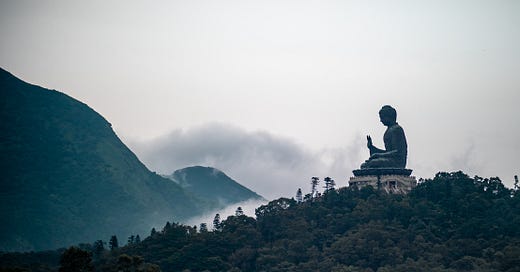A friend and I were recently exchanging notes, and she astutely posed the following:
"What if Buddha had emerged in 2022, trying to proclaim his truths over some social media platform? How would his beyond-enlightened message -- generated through month-long periods of intense introspection, just sitting and staring through deafening silence and body-numbing boredom -- resonate through all the flashing lights, naked bodies, and ceaseless noise that consumer culture demands from its "prophets" today?
And then it occurred to me -- I think we know the answer to that question, which can be cynically summed up in these three words:
No...
Entertainment...
Value.
The Buddh’a "Four Noble Truths" seem more applicable to our hyper-wired life than ever before. It's truly mind-bending, especially in light of the fact that Buddha proclaimed such verities 2,500 years ago under the now-sacred Bodhi tree. No selfies, no posts on Instagram, no dancing or swallowing Tide Pods on a Tik-Tok video...
Optimized for “Engagement” or “Enlightenment”
“As long as there is consciousness, these two potentials exist—the potential to become enlightened and the potential to suffer.” - Tashi Tsering
My friend is spot on in her assessment — as our online culture optimizes for “engagement,” our ability to get closer to enlightenment is diminished.
Like the popular concept of mindfulness, early Buddhist teachings speak to managing rumination and anxiety while emphasizing that directing our attention is important to our psychological health and overall wellness.
Where mindfulness focuses on being present and in a state of non-judgment, Buddha’s teaching takes a broader approach to meditation to bring about interpersonal, emotional, psychical, and spiritual transformation. Where mindfulness focuses on improving individual well-being (a valid goal), the Buddha’s teaching aims at the individual’s relationship to the broader world.
In the Buddhist context, mindfulness is not a means of escaping the suffering of life. Instead, mindfulness is a way of acknowledging, accepting, and utilizing suffering to better understand oneself and the world (Kirmayer, 2015).
Tashi Tsering writes in his book The Four Noble Truths: The Foundations of Buddhist Thought, “We are ignorant of the fundamental nature of the way things exist, and we feel anxiety because of this.”
This separation from the nature of the way things exist and our collective slide into the virtual world traces, I believe, the origin of the mental health epidemic plaguing not just American young people but also young people in all of the Anglosphere countries around the world. As Johnathan Haidt and his colleagues recently published, young people in Canada, the UK, Australia, and New Zealand have all followed the same trends for depression, anxiety, and mental health disorders that are evolving here in America.
Tsering, Johnathan Haidt, and his colleagues find themselves on the same page but from different intellectual approaches.
If the next generation cannot pull themselves away from their screens long enough to see how things exist, is the solution an influencer Buddha — dancing the eightfold path on TikTok?
The Four Noble Truths
The Buddha’s four noble truths are the truth of suffering, the truth of the cause of suffering, the truth of the end of suffering, and the truth of the path that leads to the end of suffering.
As I understand the Buddha’s epiphanies about the nature of life and our place in the universe, the crux is squarely in recognizing that desire is the root of suffering, often the desire to assert control in a world that is ultimately fragile.
Freedom from suffering comes from our ability to hold in our periphery that all of this — our lives, all that we know, and the world as it exists now will all come to an end — that everything is always changing. It is knowing that anything can go away in a second.
Like most Americans, I was saddened and horrified about the recent school shooting in Nashville. This was brought even closer to home when I learned that one of the children that lost her life was the niece of one of my high school classmates and friends.
His niece is almost the same age as my son.
My son’s life is tenuous; my life is tenuous. Knowing that it all could go away brings my son—and everything that matters—closer to me.
As a parent, it is difficult not to let that draw of closeness turn to fear and, in turn, a desire to control. It is a desire almost impossible to fight, but we should because if we don’t, we would miss the Buddha’s point.
This is not to say we should not work hard to reform gun legislation in the United States — gun violence and school shootings are within our collective power to solve.
I believe working toward making this country safer is not antithetical to Buddhist teachings. His lesson is more about how we hold the energy of entropy in our hearts.
How do we use it? Do we let it consume us, or do we let it pass over us in a way that pushes us toward the path of enlightenment?





